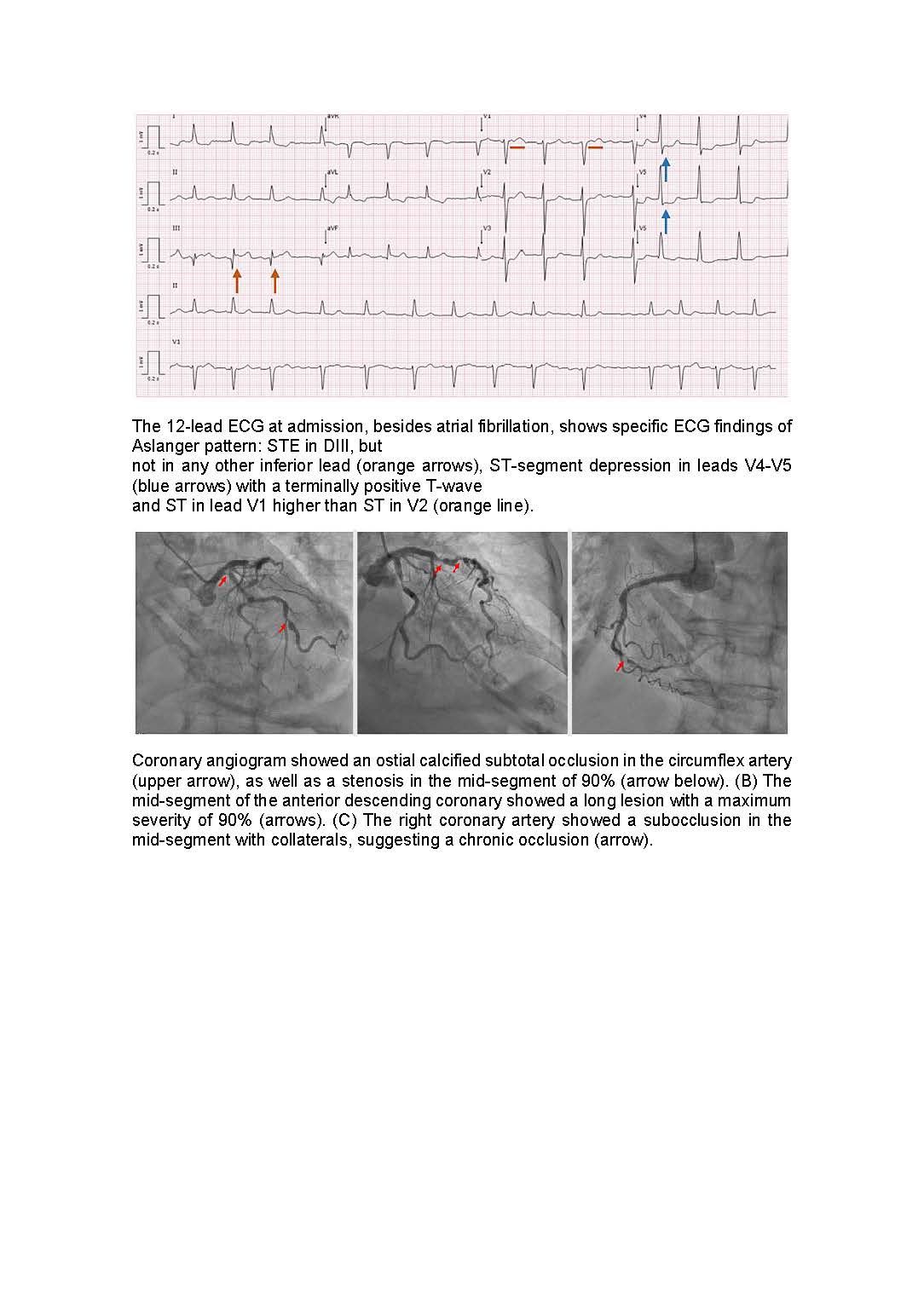Acute Inferior Myocardial Infarction: Beyond the ST-Segment Elevation
DOI:
https://doi.org/10.60591/crspmi.173Keywords:
Electrocardiography, Inferior Wall Myocardial InfarctionAbstract
Acute coronary syndromes (ACS) are considered a continuum, enclosing both non-ST-elevation (NSTE)-ACS, including unstable angina and non-ST-elevation myocardial
infarction (NSTEMI), and ST-elevation myocardial infarction
(STEMI). The diagnosis of myocardial infarction (MI) is
associated with troponin release. Classification of MI has
fundamentally been based on the presence or absence of ST-segment elevation (STE) on the electrocardiogram (ECG). STE is a poor surrogate for acute coronary occlusion (ACO) causing MI. Mounting evidence suggests that a substantial fraction of patients presenting with NSTEMI have an ACO of their culprit artery. Due to a lack of classic ECG findings, these NSTEMI patients, despite ACO of the culprit artery, may be missed, leading to either delay in or no revascularization. This case report highlights one specific pattern potentially identifying ACO that does not meet STEMI criteria, the Aslanger pattern. Early identification of this NSTEMI pattern potentially accelerates revascularization.
Downloads
References
Byrne RA, Rossello X, Coughlan JJ, Barbato E, Berry C, Chieffo A, et al. 2023 ESC Guidelines for the management of acute coronary syndromes. Eur Heart J. 2023, 12;44:3720-826. doi: 10.1093/eurheartj/ehad191
Sankardas MA, Ramakumar V, Farooqui FA. Of Occlusions, Inclusions, and Exclusions: Time to Reclassify Infarctions? Circulation. 2021, 144:333-5. doi: 10.1161/CIRCULATIONAHA.121.055827
Khan AR, Golwala H, Tripathi A. Impact of total occlusion of culprit artery in acute non-ST elevation myocardial infarction: a systematic review and meta-analysis. Eur Heart J. 2017;38:3082-89. doi: 10.1093/eurheartj/ ehx418.
Tziakas D, Chalikias G, Al-Lamee R, Kaski RC. Total coronary occlusion in non ST elevation myocardial infarction: Time to change our practice? Int J Cardiol. 2021; 329:1–8. doi: 10.1016/j.ijcard.2020.12.082
Meyers HP, Bracey A, Lee D, Lichtenheld A, Li WJ, Singer DD, et al. Accuracy of OMI ECG findings versus STEMI criteria for diagnosis of
acute coronary occlusion myocardial infarction. Int J Cardiol Heart Vasc. 2021;33:100767. doi: 10.1016/j.ijcha.2021.100767
Aslanger EK, Meyers PH 2, Smith SW: STEMI. A transitional fossil in MI classification? J Electrocardiol. 2021;65:163-9. doi: 10.1016/j.jelectrocard.2021.02.001.
Aslanger EK, Meyers HP, Bracey A, Smith SW. The STEMI/NonSTEMI Dichotomy needs to be replaced by Occlusion MI vs. Non-Occlusion MI. Int J Cardiol. 2021;330:15. doi: 10.1016/j.ijcard.2021.02.015
Meyers HP, Bracey A, Lee D, Lichtenheld A, Li WJ, Singer DD, et al. Comparison of the ST-Elevation Myocardial Infarction (STEMI) vs. NSTEMI and Occlusion MI (OMI) vs. NOMI Paradigms of Acute MI. J Emerg Med. 2021;60:273-84. doi: 10.1016/j.jemermed.2020.10.026.
Aslanger EK, Yıldırımtürk O, Simsek B, Bozbeyoglu E, Simsek MA, Yücel Karabay C, et al. DIagnostic accuracy oF electrocardiogram for acute coronary OCClUsion resuLTing in myocardial infarction (DIFOCCULT Study). Int J Cardiol Heart Vasc. 2020;30:100603. doi: 10.1016/j.ijcha.2020.100603.
Aslanger EK, Meyers HP, Smith SW. Time for a new paradigm shift in myocardial infarction. Anatol J Cardiol. 2021;25:156-62. doi: 10.5152/Anatol-JCardiol.2021.89304.
Aslanger E, Yıldırımtürk O, Simsek B, Sungur A, Türer Cabbar A, Bozbeyoglu E, et al. A new electrocardiographic pattern indicating inferior myocardial infarction. J Electrocardiol. 2020;61:41-6. doi: 0.1016/j.jelectrocard.2020.04.008.
Koyama Y, Hansen PS, Hanratty CG, Nelson GIC, Rasmussen HH. Prevalence of coronary occlusion and outcome of an immediate invasive strategy in suspected acute myocardial infarction with and without ST-segment elevation. Am J Cardiol. 2002;90:579-84. doi: 10.1016/s0002-9149(02)02559-6.
Miyauchi E, Kuwazuru K, Arikawa R, Tokutake D, Chaen H, Oketani N, Ohishi M. Clinical Features of the Aslanger Pattern to Compensate for the Limitation of ST-Elevation Myocardial Infarction (STEMI) Criteria. Cureus. 2023;15:e33227. doi:m10.7759/cureus.33227.
Al-Zaiti SS, Martin-Gill C, Zègre-Hemsey JK, Bouzid Z, Faramand Z, Alrawashdeh MO, et al. Machine learning for ECG diagnosis and risk stratification of occlusion myocardial infarction. Nature Med. 2023;29:1804–13. doi: 10.1038/s41591-023-02396-3.
Sanchis J, Núñez E, Barrabés JÁ. Randomized comparison between the invasive and conservative strategies in comorbid elderly patients with non-ST elevation myocardial infarction. Eur J Intern Med. 2016;35:89-94. doi: 10.1016/j.ejim.2016.07.003.

Downloads
Published
How to Cite
Issue
Section
Categories
License
Copyright (c) 2024 Diana Rocha, Pedro Simões, João Gouveia, Cátia Ferreira, Fátima Franco

This work is licensed under a Creative Commons Attribution 4.0 International License.






